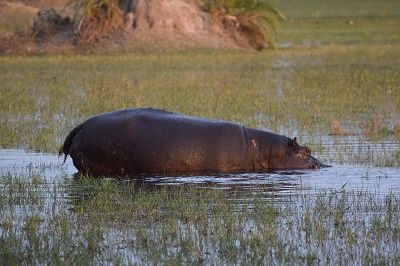Publication
Article
MD Magazine®
How to Explore Botswana's Okavango Delta
Author(s):
Botswana's Okavango Delta, stretching for some 4.45 million acres, reigns as the world's largest inland delta.

Ears twitching and snouts semi-submerged in the water, the hippos, in chorus-line formation, stare back at us as the guide maneuvers our small boat through the grass-lined channels of the flooded Okavango Delta. A young bull elephant, his reflection caught in the silvery water, cools off by arcing his trunk and spraying his back and a crocodile suns on a sandbar. Near camp, scores of tiny birds, the colors of emeralds and sapphires, flit in and out of nests burrowed in the soft mud of the banks.
Botswana’s Okavango Delta, stretching for some 4.45 million acres, reigns as the world’s largest inland delta. The region became the 1,000th UNESCO World Heritage site on June 22. Starting in late March or early April, the flood waters from Angola reach the Delta’s Kalahari sands, cresting in June or July. That’s when the desert morphs into a floodplain of reeds and grasses, when papyrus-lined waterways branch off from lagoons and wide channels of water surround the land, creating islands.
The various habitats attract different animals. Hippos don’t like deep water because they can’t swim. Instead, they bounce their thick legs off the bottom to propel themselves. Elephants swim and can handle deep lagoons, but matriarchal herds with their calves prefer mid-level or shallow depths. Lions and leopards seek dry ground.
“The best way to experience the Okavango is to do a trip that combines land-based camps with hybrid camps-- those offering water as well as land experiences. If interested in birds, also stay at a camp totally surrounded by water,” says Darren Humphreys, owner of Travel Sommelier, a company specializing in luxury safaris and wine tourism.
For the best of Botswana’s Okavango Delta, follow this guide.
Best Experiences and Lodges
Vumbura Plains
Among our favorite camps, Vumbura Plains, a hybrid camp, showcases a diversity of animals and pampers with ultra-luxurious, contemporary accommodations and great food. On a boat ride we eye hippos in the channel and savor the signature Delta scene of watery expanses laced with reeds. To catch sight of animals on the vast plains, land drives can be long and contain stretches of few animals. Nonetheless, one day we find an impala herd, warthogs, zebras, and baboons as well as watch a female lion hunting with her somewhat inept offspring. We also enjoy a rare sighting of a pack of wild dogs, a critically endangered species.
Vumbura, among the Delta’s most luxurious lodges, divides its 14 units into two camps. Each huge platform tent features a sprawling deck with a private plunge pool and a room that’s bigger than many Manhattan apartments. A wall of screens faces the marshy plain. Enjoy the view from the bed, the couch-lined sitting area, or even the shower that looks out onto the plains. One day while rinsing off, we turn to stare at an elephant slowly munching the trees outside.
Per-person rates from about $1,300 in non-flood season to $2,200, June through October.

At Abu, another favorite game lodge, we savor close encounters with the camp’s 6 elephants. As soon as we arrive at the elephant boma (corral), 7-month old Naledi runs over to us like a curious toddler, greeting us with a head butt. On walks in the wild with the herd we watch how Cathy, the matriarch, and Shirheni, Naledi’s adopted mother, nudge the calf through streams. We sit eye-level to the tree branches on elephant-back outings. When Cathy curls her trunk over her head towards us, her warm breath floats over our hand and when she rumbles, we feel her body vibrate. Afterward, we feed the elephants fistfuls of pellets, ogling their immense mouths and rows of molars. On game drives we view lechwe jumping through the wetlands and see giraffes and zebras, and at this combination land and water camp.
The 6-unit camp, decorated in shades of gray and beige, exudes an upscale casual feel. Each tent has Wi-Fi. One evening, we relax by leaning back in the deep tub on our deck to soak in a bubble bath by candlelight.
The food is tasty and the service, excellent. Per-person rates from about $1,800 in non-flood season to $2,600, June through October.
Mombo Camp
Located on Chief’s Island, the Okavango’s largest landmass, Mombo, a land-based facility, rates as a top camp. Mombo’s location gives it prime access to some of the Delta’s densest concentration of animals. We see herds of impala, zebra and elephant as well as spotted hyena and giraffe. The highlight: a pride of lions with young cubs. We watch the months-old critters nurse, climb on their moms, and paw each other in play. In addition, Chief’s Island has rhino that have been recently relocated from South Africa to better protect them from poachers.
Mombo’s nine unit camp was rebuilt in 2000. Although comfortable, the room’s long and narrow configuration is somewhat awkward for us and the beds are surprisingly small. Instead of the double or full twins at other lodges, Mombo’s units have almost cot-like beds. That said, the lodge serves good food and delivers first-rate wildlife sightings.
Per-person rates from about $1,800 in non-flood season to about $2,600 June through October.
Wilderness Safaris operates but does not book camps. To inquire about accommodations and safaris, contact Travel Sommelier, www.travelsommelier.com, 203-286-8338.
​Photos copyright Alissa Kempler.
